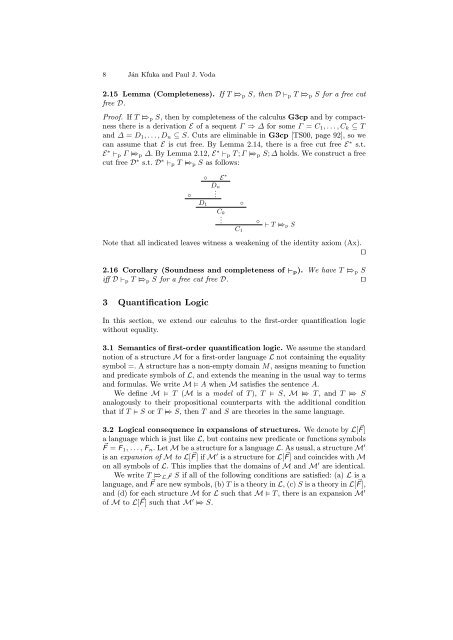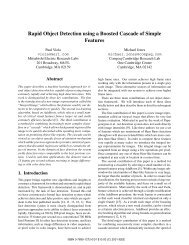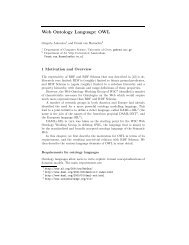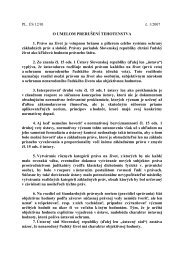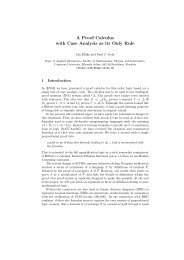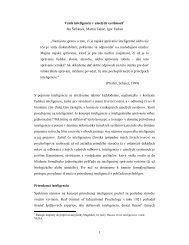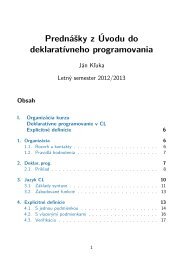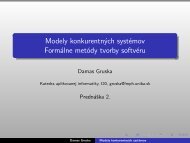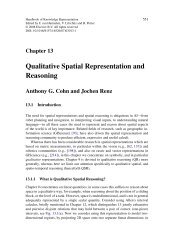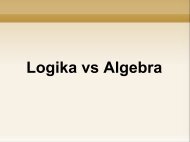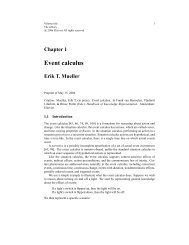A Simple and Practical Valuation Tree Calculus for First-Order Logic
A Simple and Practical Valuation Tree Calculus for First-Order Logic
A Simple and Practical Valuation Tree Calculus for First-Order Logic
Create successful ePaper yourself
Turn your PDF publications into a flip-book with our unique Google optimized e-Paper software.
8 Ján Kľuka <strong>and</strong> Paul J. Voda2.15 Lemma (Completeness). If T ⇒ p S, then D ⊢p T ⇒ p S <strong>for</strong> a free cutfree D.Proof. If T ⇒ p S, then by completeness of the calculus G3cp <strong>and</strong> by compactnessthere is a derivation E of a sequent Γ ⇒ ∆ <strong>for</strong> some Γ = C 1 , . . . , C k ⊆ T<strong>and</strong> ∆ = D 1 , . . . , D n ⊆ S. Cuts are eliminable in G3cp [TS00, page 92], so wecan assume that E is cut free. By Lemma 2.14, there is a free cut free E ∗ s.t.E ∗ ⊢p Γ ⇒ p ∆. By Lemma 2.12, E ∗ ⊢p T ; Γ ⇒ p S; ∆ holds. We construct a freecut free D ∗ s.t. D ∗ ⊢p T ⇒ p S as follows:◦D 1◦ E ∗D n.C k◦. ◦ ⊢ T ⇒p SC 1Note that all indicated leaves witness a weakening of the identity axiom (Ax).⊓⊔2.16 Corollary (Soundness <strong>and</strong> completeness of ⊢p). We have T ⇒ p Siff D ⊢p T ⇒ p S <strong>for</strong> a free cut free D.⊓⊔3 Quantification <strong>Logic</strong>In this section, we extend our calculus to the first-order quantification logicwithout equality.3.1 Semantics of first-order quantification logic. We assume the st<strong>and</strong>ardnotion of a structure M <strong>for</strong> a first-order language L not containing the equalitysymbol =. A structure has a non-empty domain M, assigns meaning to function<strong>and</strong> predicate symbols of L, <strong>and</strong> extends the meaning in the usual way to terms<strong>and</strong> <strong>for</strong>mulas. We write M A when M satisfies the sentence A.We define M T (M is a model of T ), T S, M ⇒ T , <strong>and</strong> T ⇒ Sanalogously to their propositional counterparts with the additional conditionthat if T S or T ⇒ S, then T <strong>and</strong> S are theories in the same language.3.2 <strong>Logic</strong>al consequence in expansions of structures. We denote by L[ ⃗ F ]a language which is just like L, but contains new predicate or functions symbols⃗F = F 1 , . . . , F n . Let M be a structure <strong>for</strong> a language L. As usual, a structure M ′is an expansion of M to L[ ⃗ F ] if M ′ is a structure <strong>for</strong> L[ ⃗ F ] <strong>and</strong> coincides with Mon all symbols of L. This implies that the domains of M <strong>and</strong> M ′ are identical.We write T ⇒ L, ⃗ F S if all of the following conditions are satisfied: (a) L is alanguage, <strong>and</strong> ⃗ F are new symbols, (b) T is a theory in L, (c) S is a theory in L[ ⃗ F ],<strong>and</strong> (d) <strong>for</strong> each structure M <strong>for</strong> L such that M T , there is an expansion M ′of M to L[ ⃗ F ] such that M ′ ⇒ S.


